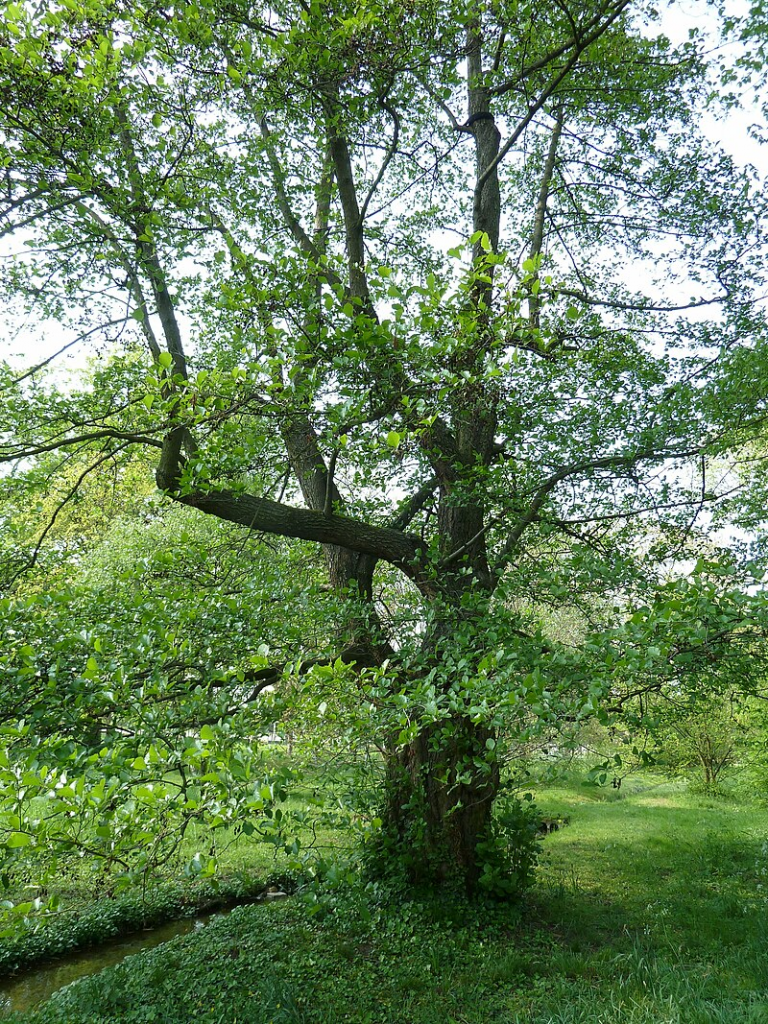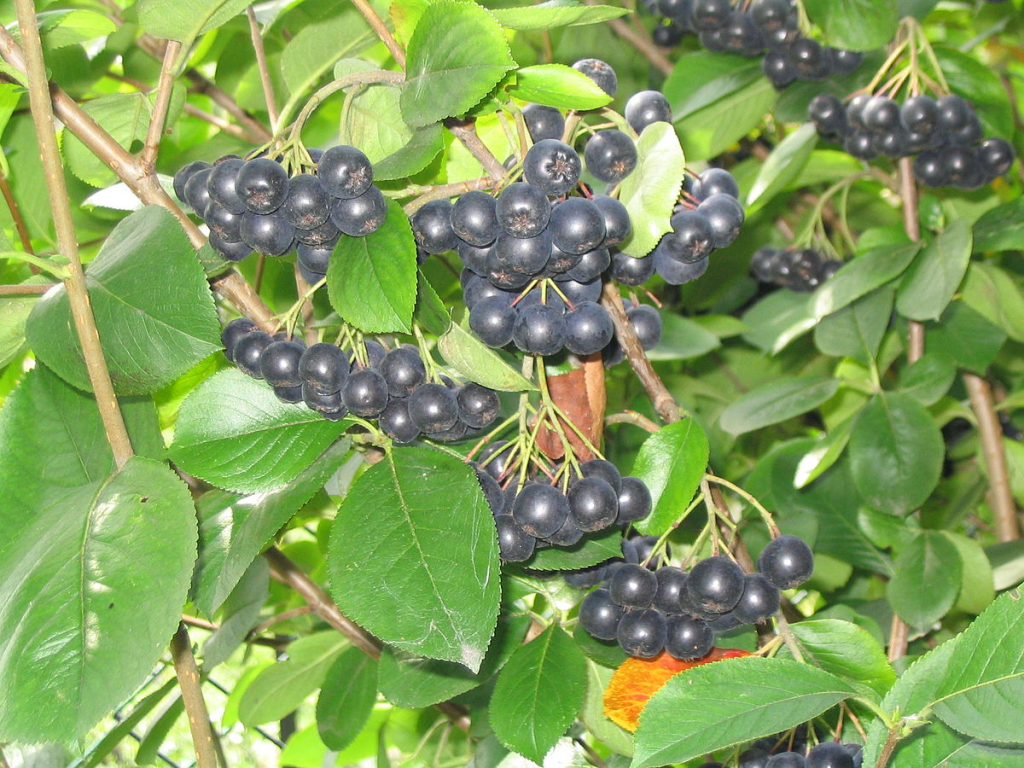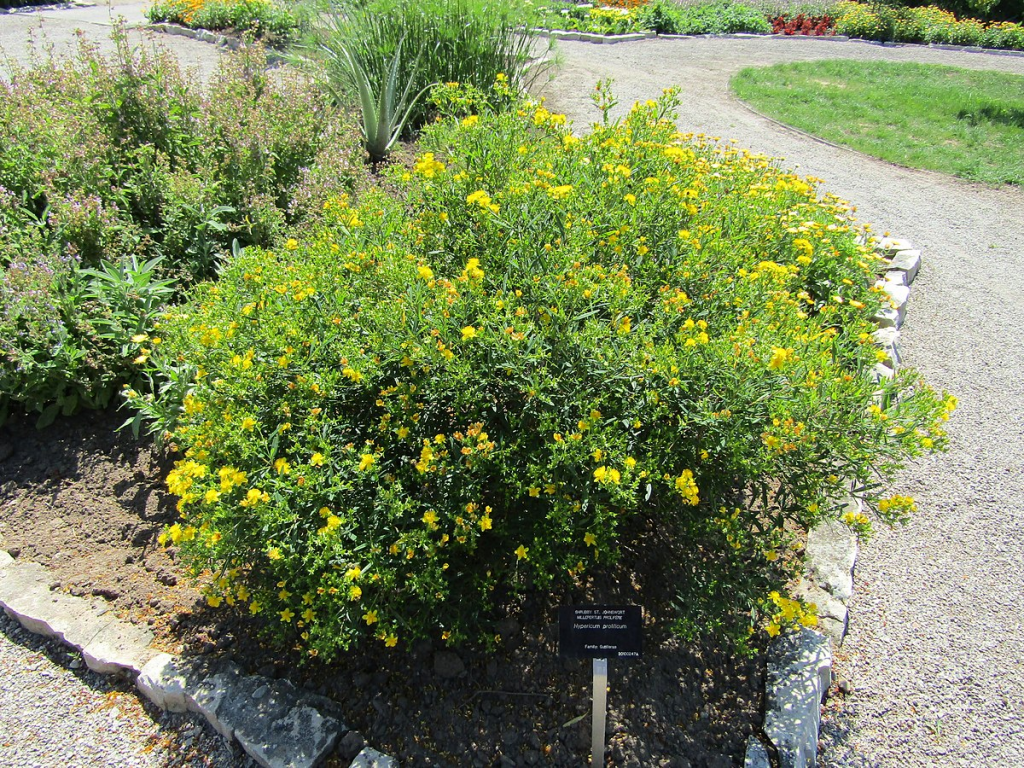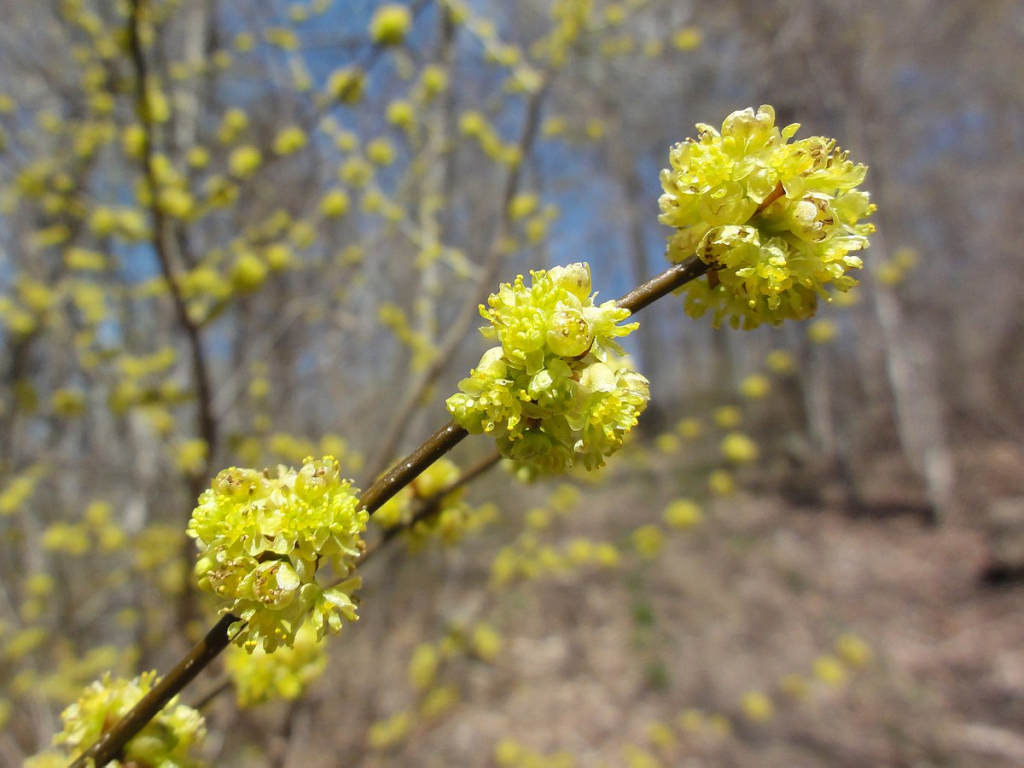
The following shrubs are suitable for the area of a rain garden that is the deepest and holds the most water for the most amount of time. They can tolerate standing in up to 6″ of water for about 24 hours. All but swamp rose and swamp azalea are also suitable for the middle area of a rain garden that holds several inches of water during and immediately after a rain fall but drains more quickly. Most of the shrubs tolerate some shade and many provide interest to the rain garden such as flowers, fall coloration, and interesting bark. Although all of the shrubs are suitable for most of the East Coast, they vary in their hardiness and heat tolerance. This list is not meant to be comprehensive but intends to provide an interesting assortment of shrubs that may be used. Photo Credit Wikipedia
Smooth Alder (Alnus serrulata)

Also known as tag alder, brookside alder, and hazel alder, this deciduous shrub or small tree is native to eastern North America from Nova Scotia and southern New Brunswick south to northern Florida and eastern Texas where it grows in wet soils such as streambanks, riversides, and swamps. The plants grow 10-20′ tall and have dark green leaves 2-5″ long. Yellow male catkins and short reddish to purple female catkins appear on the same tree in late spring. Photo Credit Aroche, Wikimedia Commons
Type: Deciduous shrub or small tree
Height: 10-20′
Light: Sun to part shade
Hardiness: Zones 4-9
Black Chokeberry (Aronia melanocarpa)

Black chokeberry is a mounding to rounded deciduous shrub growing up to 6’ tall and native to swamp, woodland clearings, wetland forests, and outcroppings from Newfoundland to Ontario, south to Georgia and Arkansas. It has dark green foliage that turns crimson to burgundy-red in the fall, white flowers with pink anthers in mid spring, and glossy black fruit in late summer. Photo Credit: Goku 122, Wikimedia Commons
Type: Deciduous shrub
Height: 3-6′
Light: Full sun to partial shade
Hardiness: Zones 3-9
Buttonbush (Cephalanthus occidentalis)

Also called honey-bells and button-willow, this deciduous shrub or small tree is native to wetlands such as swamps, marshes, riverbanks, and floodplains from New Brunswick and Minnesota south to Florida and Mexico, west to California. The plants grow 5-12′ tall and have oval glossy green leaves up to 6′ long and dense spherical cluster of tiny sweet-smelling white flowers. Photo Credit Wikipedia
Type: Deciduous shrub or small tree
Height: 5-12′
Light: Full sun to partial shade
Hardiness: Zones 5-10
Silky Dogwood (Cornus amomum aka Swida amomum)

Also known as pale dogwood, swamp dogwood, red willow, silky cornel, kinnikinnick, and squawbush this deciduous shrub is native to parts of Canada and eastern and central US, from Vermont and Michigan south to Florida and Alabama where it grows near streams and ponds and in wetlands, floodplains, and swamp borders. The shrub grows 6-12′ tall and has an open rounded form. The oval to elliptic leaves are 2-5″ long and are medium to dark green before turning purplish-red in the fall. Creamy-white flowers appear in flat topped clusters and are followed by clusters of round berry-like fruits that change color from white to blue as they ripen. Photo Credit: SB Johnny, Wikipedia
Type: Flowering deciduous shrub
Height: 6-12′
Light: Sun to partial shade; tolerates heavy shade
Hardiness: Zones 5-8
Shrubby St. Johnswort (Hypericum prolificum)

This native of eastern and central United States is a small compact deciduous shrub with medium texture and rounded form. It has yellow flowers about one inch across and dark green linear leaves about one to three inches long. The light brown bark of older stems is exfoliating to reveal the pale orange inner bark. Photo Credit Leonora (Ellie) Enking, Wikimedia Commons
Type: Flowering deciduous shrub
Height: 1-5’ H x 14’ W
Light: Full sun to partial shade
Hardiness: Zones 4-9
Winterberry (Ilex verticillata)

This deciduous holly is native to eastern North America from Newfoundland west to Ontario and Minnesota, south to Alabama where it grows in wetlands such as bogs, swamps, and along streams and ponds, as well as in drier sites. Known also as black alder, Canada holly, coralberry, feverbush, and Michigan holly, it grows 3-16′ tall and has dark green leaves that are oblong to ovate, and 2-4″ long. Small, inconspicuous, greenish-white male and female flowers appear in the leaf axils of different plants in late spring. If pollinated, the female flowers produce a red berry-like fruit 1/4″ in diameter and bearing a terminal black dot. Photo Credit Wikipedia
Type: Deciduous shrub
Height: 3-16′
Light: Full sun to part shade
Hardiness: Zones 3-9
Spicebush (Lindera benzoin)

Native to eastern North America from Maine to northern Florida and west to Ontario, Kansas, and Texas this deciduous shrub grows in moist areas of woods especially where there is exposed limestone. Plants grow 6-12′ tall and wide, and have thick light green leaves that are 3-6″ long, oblong-obovate and turn bright yellow in the fall. Clusters of tiny, greenish-yellow male and female flowers appear on different plants in early spring before the leaves emerge. Pollinated female flowers give way to bright red berries in the fall. Photo Credit: R. A. Nonenmacher, Wikimedia Commons
Type: Flowering deciduous shrub
Height: 6-12′
Light: Full sun to part shade
Hardiness: Zones 4-9
Ninebark (Physocarpus opulifolius)

This mounding to rounded deciduous shrub is native to open woods, lakeshores, streambanks, rock outcroppings, and prairies in central and eastern US from New Brunswick to Ontario, south to Georgia and Arkansas. It grows 3-10′ tall and has arching branches with brown bark that turns gray and exfoliates when mature to reveal layers of reddish to light brown inner bark. The ovate to rounded leaves are 1.5-5″ long and are dull green until turning dull yellow in the fall. From late spring to early summer white flowers appear in terminal round to dome-shape clusters, 3/4-2.25″ across. Drooping clusters of greenish red to red pods follow in late summer and fall and persist into winter. Photo Credit Wikipedia
Type: Flowering deciduous shrub
Height: 3-10′
Light: Full sun to part shade (afternoon shade in hot summers)
Hardiness: Zones 3-8
Swamp Azalea (Rhododendron viscosum)

Also known as clammy azalea, and swamp honeysuckle, this flowering deciduous shrub is native to the wetlands of eastern and southern US. It grows up to 8′ tall and becomes spreading with maturity. The leathery, oval leaves are up to 2.5″ long and are dark green before turning yellow, orange and purple in fall. Clusters of clove-scented, white to pink flowers appear from late spring into summer. Photo Credit Wikipedia
Type: Flowering deciduous shrub
Size: 2-8′ H
Light: Dappled or part shade
Hardiness: Zones 4-9
Swamp Rose (Rosa palustris)

This suckering deciduous shrub is native to eastern North America from Nova Scotia and New Brunswick, south to Florida and west to Arkansas and Ontario where it occurs along stream banks and in swamps, marshes, and floodplains. It grows 3-6′ tall and wide and has arching branches with stout curved prickles. The pinnately compound leaves have 5 to 9 (usually 7) leaflets that are broadly elliptic or ovate, 1.25- 2.5″ long, medium to dark green in summer, often turning red in the fall. Single pink flowers with conspicuous yellow stamens appear from late spring to mid summer and last 6-8 weeks. Photo Credit: SB Johnny Wikimedia
Type: Flowering deciduous shrub
Height: 3-6′ H x 3-6′ W
Light: Full sun to part shade but best flowering is in full sun
Hardiness: Zones 4-9
Common Elderberry (Sambucus canadensis aka Sambucus nigra subsp. canadensis)

Also called American elder, this deciduous shrub or small tree is native to North America east of the Rocky Mountains, south to Bolivia, where it usually grows in moist areas such as floodplains, wet ditches, marshland edges, and thickets. It grows up to 12′ tall with an equal or greater width, and has arching branches and a rounded form. The compound leaves have 5-11 leaflets (usually 7) that are 2-5″ long, oval to lance-shaped, and are green in summer, turning yellow in the fall. , Creamy-white, star-shaped flowers appear in rounded or flat topped clusters In early to mid summer . Photo Credit H. Zell Wikimedia Commons
Type: Flowering deciduous shrub or small tree
Height: 5-12′ H x 6-12′ W
Light: Full sun to partial shade.
Hardiness: Zones 3-9
Blue Haw (Viburnum cassinoides)

Also known as Appalachian tea, wild raisin, swamp haw, withe-rod and witherrod viburnum, this deciduous shrub is native to eastern North America from Newfoundland to Manitoba and Minnesota, south to Georgia, where it grows in wet areas such as along streams and ponds edges and in bogs and swamps. The plant usually grows 5-6′ tall and wide, and has a dense rounded form with arching branches. The leaves are 1.5-3.5″ long, ovate or oblong, and are chocolate to bronze-tinted when they emerge but turn dark green in summer, and then orange-red, to crimson or purple in the fall. Flat-topped clusters of creamy white flowers with yellow stamens appear in the spring. The small fruits that follows are berry-like, green at first, turning pink, to red, to blue, and to black in the fall. Often berries of all colors are present in a single cluster. Photo Credit: Fungus Guy, Wikimedia Commons
Type: Flowering deciduous shrub
Height: 5-12′ H (but usually 10′ or less) x 5-8′ W
Light: Full sun to part shade
Hardiness: Zones 3-8
Smooth Witherod (Viburnum nudum)

Also known as withe-rod, possumhaw, and wild raisin, this deciduous shrub is native to eastern North America where it lives in swamps, bogs, and low woods. It grows up to 12′ tall and wide, and has a dense rounded form and spreading arching branches. The leaves are elliptical to oblong, up to 4″ long, and are glossy dark green in summer, sometimes turning reddish purple in the fall In late spring to early summer. In late spring, fragrant, creamy white flowers appear in flat-topped clusters 2-5″ across. Clusters of edible berries follow and change color as they ripen from light pink to deep pink to blue to purplish-black with all colors appearing at the same time. Photo Credit SB Johnny, Wikimedia Commons
Type: Flowering deciduous shrub
Height: 5-12′
Light: Full sun to partial shade
Hardiness: Zones 5-9